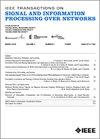边缘中心应用的混合监督与自监督图神经网络
IF 3
3区 计算机科学
Q2 ENGINEERING, ELECTRICAL & ELECTRONIC
IEEE Transactions on Signal and Information Processing over Networks
Pub Date : 2025-09-17
DOI:10.1109/TSIPN.2025.3611172
引用次数: 0
摘要
本文提出了一个基于小说的深度学习模型,用于涉及两个节点之间关系的任务(以边缘为中心的任务),其重点是预测节点对之间的关系和交互,而不是节点本身的属性。该模型结合了监督学习和自监督学习,考虑了学习到的嵌入的损失函数和有或没有基础真值的模式。此外,它还结合了一个注意机制,可以同时利用节点和边缘特征。该体系结构经过端到端训练,包括两个主要组件:嵌入生成和预测。首先,图神经网络(GNN)将原始节点特征转换为密集的低维嵌入,并结合边缘属性。然后,前馈神经模型处理节点嵌入以产生最终输出。实验表明,我们的模型匹配或超过了现有的蛋白质-蛋白质相互作用预测和基因本体(GO)术语预测方法。该模型还可以有效地对节点特征进行单热编码,为预测结构未知的化合物之间的相似性提供了一个解决方案。本文章由计算机程序翻译,如有差异,请以英文原文为准。
A Hybrid Supervised and Self-Supervised Graph Neural Network for Edge-Centric Applications
This paper presents a novelgraph-based deep learning model for tasks involving relations between two nodes (edge-centric tasks), where the focuslies on predicting relationships and interactions between pairs of nodes rather than node properties themselves. This model combines supervised and self-supervisedlearning, taking into account for the loss function the embeddings learned and patterns with and without ground truth. Additionally it incorporates an attention mechanism that leveragesboth node and edge features. The architecture, trained end-to-end, comprises two primary components: embedding generation and prediction. First, a graph neural network (GNN) transform raw node features into dense, low-dimensional embeddings, incorporating edge attributes. Then, a feedforward neural model processes the node embeddings to produce the final output. Experiments demonstrate that our model matches or exceeds existing methods for protein-protein interactions prediction and Gene Ontology (GO) terms prediction. The model also performs effectively with one-hot encoding for node features, providing a solution for the previously unsolved problem of predicting similarity between compounds with unknown structures.
求助全文
通过发布文献求助,成功后即可免费获取论文全文。
去求助
来源期刊

IEEE Transactions on Signal and Information Processing over Networks
Computer Science-Computer Networks and Communications
CiteScore
5.80
自引率
12.50%
发文量
56
期刊介绍:
The IEEE Transactions on Signal and Information Processing over Networks publishes high-quality papers that extend the classical notions of processing of signals defined over vector spaces (e.g. time and space) to processing of signals and information (data) defined over networks, potentially dynamically varying. In signal processing over networks, the topology of the network may define structural relationships in the data, or may constrain processing of the data. Topics include distributed algorithms for filtering, detection, estimation, adaptation and learning, model selection, data fusion, and diffusion or evolution of information over such networks, and applications of distributed signal processing.
 求助内容:
求助内容: 应助结果提醒方式:
应助结果提醒方式:


